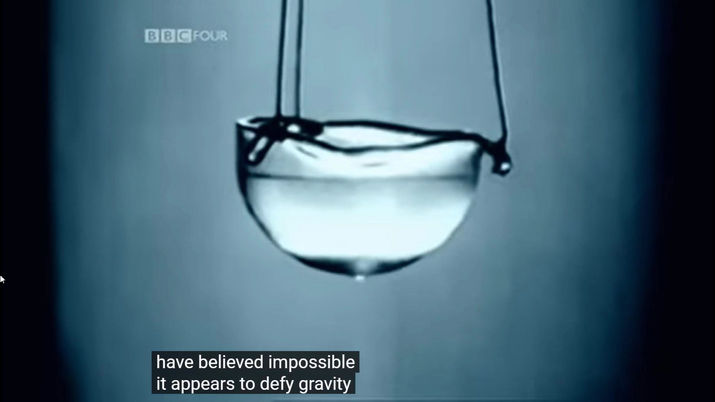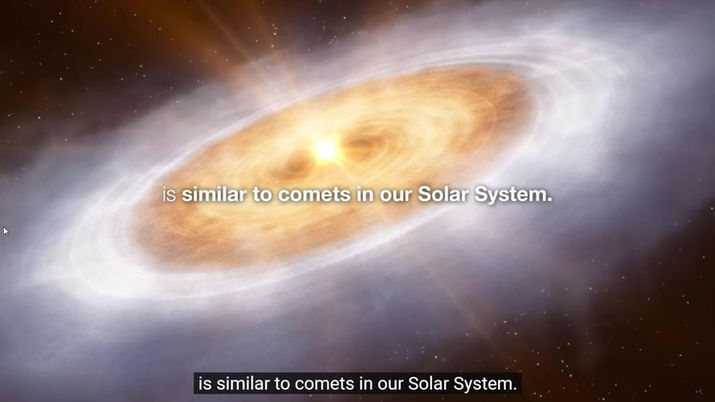top of page

Explore Open Science

Physics :
Helium Superfluid
Helium (from Greek: ἥλιος, romanized: helios, lit. 'sun') is a chemical element with the symbol He and atomic number 2. It is a colorless, odorless, tasteless, non-toxic, inert, monatomic gas and the first in the noble gas group in the periodic table.[a] Its boiling point is the lowest among all the elements, and it does not have a melting point at standard pressure. It is the second-lightest and second most abundant element in the observable universe, after hydrogen. It is present at about 24% of the total elemental mass, which is more than 12 times the mass of all the heavier elements combined. Its abundance is similar to this in both the Sun and Jupiter, because of the very high nuclear binding energy (per nucleon) of helium-4, with respect to the next three elements after helium. This helium-4 binding energy also accounts for why it is a product of both nuclear fusion and radioactive decay. The most common isotope of helium in the universe is helium-4, the vast majority of which was formed during the Big Bang. Large amounts of new helium are created by nuclear fusion of hydrogen in stars.
Music :
Rhim - Cafe de Anatolia
From Dust Records Archive
https://www.instagram.com/from_dust_records/reels/
Music :
Rhim - Cafe de Anatolia
From Dust Records Archive
https://www.instagram.com/from_dust_records/reels/

Astrophysics :
The Missing Link for Water in the Solar System (ESOcast 258 Light)
8 mar 2023 Bite-Sized Astronomy News
Using ALMA, astronomers have detected the chemical signature of gaseous water in the planet-forming disc V883 Orionis. This acts as a timestamp for the water’s formation, allowing us to trace its journey.
Credit:
ESO
Directed by: Herbert Zodet and Martin Wallner.
Editing: Herbert Zodet.
Web and technical support: Gurvan Bazin and Raquel Yumi Shida.
Written by: Rebecca Forsberg and Rory Harris.
Music: Stellardrone — Satellite.
Footage and photos: ESO, ALMA (ESO/NAOJ/NRAO) and L. Calçada.
Scientific consultants: Paola Amico and Mariya Lyubenova.
More information and download options:
https://www.eso.org/public/videos/eso2302a/
Music:
Pink Floyd - shine On Your Crazy Diamond
From Dust Records Archive
https://www.instagram.com/from_dust_records/reels/
Using ALMA, astronomers have detected the chemical signature of gaseous water in the planet-forming disc V883 Orionis. This acts as a timestamp for the water’s formation, allowing us to trace its journey.
Credit:
ESO
Directed by: Herbert Zodet and Martin Wallner.
Editing: Herbert Zodet.
Web and technical support: Gurvan Bazin and Raquel Yumi Shida.
Written by: Rebecca Forsberg and Rory Harris.
Music: Stellardrone — Satellite.
Footage and photos: ESO, ALMA (ESO/NAOJ/NRAO) and L. Calçada.
Scientific consultants: Paola Amico and Mariya Lyubenova.
More information and download options:
https://www.eso.org/public/videos/eso2302a/
Music:
Pink Floyd - shine On Your Crazy Diamond
From Dust Records Archive
https://www.instagram.com/from_dust_records/reels/

Earth Geology :
Volcano's
A volcano is a mountain that has lava (hot, liquid rock) coming out from a magma chamber under the ground, or did have in the past. Volcanoes[1] are formed by the movement of tectonic plates.
The Earth's crust has 17 major, rigid tectonic plates. These float on a hotter, softer layer in its mantle.[2] Volcanoes are often found where tectonic plates are coming together.
Volcanoes can also form where there is stretching and thinning of the crust's plates, e.g., in the East African Rift.[3] Volcanoes are usually not found where two tectonic plates slide past one another.
Volcanism away from plate boundaries is caused by mantle plumes. These so-called "hotspots", for example Hawaii, are thought to arise from upwelling magma from the core–mantle boundary, 3,000 km deep in the Earth.
Most volcanoes have a volcanic crater at the top. When a volcano is active, materials come out of it. The materials include lava, steam, gaseous sulfur compounds, ash and broken rock pieces.
When there is enough pressure, the volcano erupts. Some volcanic eruptions blow off the top of the volcano. Sometimes, the magma comes out quickly and sometimes it comes slowly. Some eruptions come out at a side instead of the top.
Volcanoes are found on planets other than Earth. An example is Olympus Mons on Mars.
Music :
The Show Must Go On - Queen
From Dust Records Archive
https://www.instagram.com/from_dust_records/reels/
The Earth's crust has 17 major, rigid tectonic plates. These float on a hotter, softer layer in its mantle.[2] Volcanoes are often found where tectonic plates are coming together.
Volcanoes can also form where there is stretching and thinning of the crust's plates, e.g., in the East African Rift.[3] Volcanoes are usually not found where two tectonic plates slide past one another.
Volcanism away from plate boundaries is caused by mantle plumes. These so-called "hotspots", for example Hawaii, are thought to arise from upwelling magma from the core–mantle boundary, 3,000 km deep in the Earth.
Most volcanoes have a volcanic crater at the top. When a volcano is active, materials come out of it. The materials include lava, steam, gaseous sulfur compounds, ash and broken rock pieces.
When there is enough pressure, the volcano erupts. Some volcanic eruptions blow off the top of the volcano. Sometimes, the magma comes out quickly and sometimes it comes slowly. Some eruptions come out at a side instead of the top.
Volcanoes are found on planets other than Earth. An example is Olympus Mons on Mars.
Music :
The Show Must Go On - Queen
From Dust Records Archive
https://www.instagram.com/from_dust_records/reels/

The Human Body :
Muscles used in Running
Running is a method of terrestrial locomotion allowing humans and other animals to move rapidly on foot. Running is a type of gait characterized by an aerial phase in which all feet are above the ground (though there are exceptions).[1] This is in contrast to walking, where one foot is always in contact with the ground, the legs are kept mostly straight and the center of gravity vaults over the stance leg or legs in an inverted pendulum fashion.[2] A feature of a running body from the viewpoint of spring-mass mechanics is that changes in kinetic and potential energy within a stride co-occur, with energy storage accomplished by springy tendons and passive muscle elasticity.[3] The term running can refer to any of a variety of speeds ranging from jogging to sprinting.
Running in humans is associated with improved health and life expectancy.[4]
It is hypothesized that the ancestors of humankind developed the ability to run for long distances about 2.6 million years ago, probably to hunt animals.[5][6] Competitive running grew out of religious festivals in various areas. Records of competitive racing date back to the Tailteann Games in Ireland between 632 BCE and 1171 BCE,[7][8][9] while the first recorded Olympic Games took place in 776 BCE. Running has been described as the world's most accessible sport.
From Dust Records Archive
https://www.instagram.com/from_dust_records/reels/
Running in humans is associated with improved health and life expectancy.[4]
It is hypothesized that the ancestors of humankind developed the ability to run for long distances about 2.6 million years ago, probably to hunt animals.[5][6] Competitive running grew out of religious festivals in various areas. Records of competitive racing date back to the Tailteann Games in Ireland between 632 BCE and 1171 BCE,[7][8][9] while the first recorded Olympic Games took place in 776 BCE. Running has been described as the world's most accessible sport.
From Dust Records Archive
https://www.instagram.com/from_dust_records/reels/

Molecular Genetics :
DNA animation (2002-2014) by Drew Berry and Etsuko Uno wehi.tv #ScienceArt
Deoxyribonucleic acid (/diːˈɒksɪˌraɪboʊnjuːˌkliːɪk, -ˌkleɪ-/ ⓘ;[1] DNA) is a polymer composed of two polynucleotide chains that coil around each other to form a double helix. The polymer carries genetic instructions for the development, functioning, growth and reproduction of all known organisms and many viruses. DNA and ribonucleic acid (RNA) are nucleic acids. Alongside proteins, lipids and complex carbohydrates (polysaccharides), nucleic acids are one of the four major types of macromolecules that are essential for all known forms of life.
The two DNA strands are known as polynucleotides as they are composed of simpler monomeric units called nucleotides.[2][3] Each nucleotide is composed of one of four nitrogen-containing nucleobases (cytosine [C], guanine [G], adenine [A] or thymine [T]), a sugar called deoxyribose, and a phosphate group. The nucleotides are joined to one another in a chain by covalent bonds (known as the phosphodiester linkage) between the sugar of one nucleotide and the phosphate of the next, resulting in an alternating sugar-phosphate backbone. The nitrogenous bases of the two separate polynucleotide strands are bound together, according to base pairing rules (A with T and C with G), with hydrogen bonds to make double-stranded DNA. The complementary nitrogenous bases are divided into two groups, the single-ringed pyrimidines and the double-ringed purines. In DNA, the pyrimidines are thymine and cytosine; the purines are adenine and guanine.
Music :
Tick Tick Boom - Sage The Gemini ft. BygTwo3
From Dust Records Archive
https://www.instagram.com/from_dust_records/reels/
https://www.youtube.com/watch?v=7Hk9jct2ozY
The two DNA strands are known as polynucleotides as they are composed of simpler monomeric units called nucleotides.[2][3] Each nucleotide is composed of one of four nitrogen-containing nucleobases (cytosine [C], guanine [G], adenine [A] or thymine [T]), a sugar called deoxyribose, and a phosphate group. The nucleotides are joined to one another in a chain by covalent bonds (known as the phosphodiester linkage) between the sugar of one nucleotide and the phosphate of the next, resulting in an alternating sugar-phosphate backbone. The nitrogenous bases of the two separate polynucleotide strands are bound together, according to base pairing rules (A with T and C with G), with hydrogen bonds to make double-stranded DNA. The complementary nitrogenous bases are divided into two groups, the single-ringed pyrimidines and the double-ringed purines. In DNA, the pyrimidines are thymine and cytosine; the purines are adenine and guanine.
Music :
Tick Tick Boom - Sage The Gemini ft. BygTwo3
From Dust Records Archive
https://www.instagram.com/from_dust_records/reels/
https://www.youtube.com/watch?v=7Hk9jct2ozY

Explore The Universe
Map Of The Know Universe
Music:
Phantogram•When I'm Small
From Dust Records Archive
https://www.instagram.com/from_dust_records/reels/
Music:
Phantogram•When I'm Small
From Dust Records Archive
https://www.instagram.com/from_dust_records/reels/

Discover Exoplanet :
Kepler-186f
Kepler-186f (also known by its Kepler object of interest designation KOI-571.05) is an exoplanet orbiting the red dwarf Kepler-186, about 580 light-years (180 parsecs) from Earth.
Size comparison of Kepler-186f (artist's impression) with Earth along with their projected habitable zones.
DiscoveryDiscovered byElisa QuintanaDiscovery siteKepler Space Observatory Discovery date17 April 2014
It was the first planet with a radius similar to Earth's to be discovered in the habitable zone of another star. NASA's Kepler space telescope detected it using the transit method, along with four additional planets orbiting much closer to the star (all modestly larger than Earth).
Analysis of three years of data was required to find its signal. The results were presented initially at a conference on 19 March 2014 and some details were reported in the media at the time. The public announcement was on 17 April 2014, followed by publication in Science.
Music:
MGMT•Kids
Credits:
@wikipedia
@nasa
From Dust Records Archive
https://www.instagram.com/from_dust_records/reels/
Size comparison of Kepler-186f (artist's impression) with Earth along with their projected habitable zones.
DiscoveryDiscovered byElisa QuintanaDiscovery siteKepler Space Observatory Discovery date17 April 2014
It was the first planet with a radius similar to Earth's to be discovered in the habitable zone of another star. NASA's Kepler space telescope detected it using the transit method, along with four additional planets orbiting much closer to the star (all modestly larger than Earth).
Analysis of three years of data was required to find its signal. The results were presented initially at a conference on 19 March 2014 and some details were reported in the media at the time. The public announcement was on 17 April 2014, followed by publication in Science.
Music:
MGMT•Kids
Credits:
@wikipedia
@nasa
From Dust Records Archive
https://www.instagram.com/from_dust_records/reels/

Scientific Pitch :
432 Hz
432 Hz tuning believe that this “heartbeat” resonates sympathetically with music tuned to A-432, such that our bodies' atoms, thought waves, and even our DNA respond positively as we listen.
.
According to the results of our study, binaural beats and 432 Hz music are effective in reducing preoperative dental anxiety. Both methods decreased the anxiety. When two groups were compared, no statistical difference was found between them. However, the 432 Hz was found to be more effective in reducing the anxiety.
.
"Did you know that JIMI HENDRIX, along with JOHN LENNON, Bob Marley and Prince all tuned their music to a specific FREQUENCY OF 432Hz!” reads a much-shared social media post.
.
For some listeners, the benefits of 432 Hz music go beyond an experience of physical relaxation and emotional well-being. Although there is a paucity of scientific studies dedicated to this subject, some listeners report using 432 Hz to alleviate chronic pain and other physical symptoms.
.
Results: 432 Hz tuned music was associated with a slight decrease of mean (systolic and diastolic) blood pressure values (although not significant), a marked decrease in the mean of heart rate (-4.79 bpm, p = 0.05) and a slight decrease of the mean respiratory rate values (1 r.a., p = 0.06), compared to 440 Hz.
.
Music:
SavaBorsa, Arnaldo Herrera•La Voz de la Vibración
Sample of an essential Loop
From Dust Records Archive
https://www.instagram.com/from_dust_records/reels/
.
According to the results of our study, binaural beats and 432 Hz music are effective in reducing preoperative dental anxiety. Both methods decreased the anxiety. When two groups were compared, no statistical difference was found between them. However, the 432 Hz was found to be more effective in reducing the anxiety.
.
"Did you know that JIMI HENDRIX, along with JOHN LENNON, Bob Marley and Prince all tuned their music to a specific FREQUENCY OF 432Hz!” reads a much-shared social media post.
.
For some listeners, the benefits of 432 Hz music go beyond an experience of physical relaxation and emotional well-being. Although there is a paucity of scientific studies dedicated to this subject, some listeners report using 432 Hz to alleviate chronic pain and other physical symptoms.
.
Results: 432 Hz tuned music was associated with a slight decrease of mean (systolic and diastolic) blood pressure values (although not significant), a marked decrease in the mean of heart rate (-4.79 bpm, p = 0.05) and a slight decrease of the mean respiratory rate values (1 r.a., p = 0.06), compared to 440 Hz.
.
Music:
SavaBorsa, Arnaldo Herrera•La Voz de la Vibración
Sample of an essential Loop
From Dust Records Archive
https://www.instagram.com/from_dust_records/reels/
bottom of page





.png)